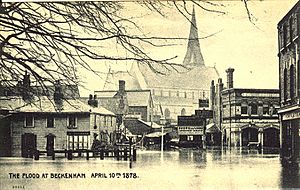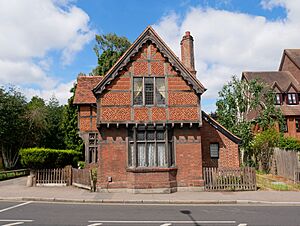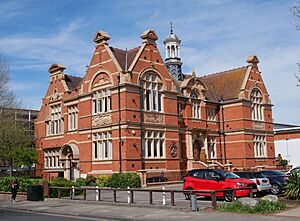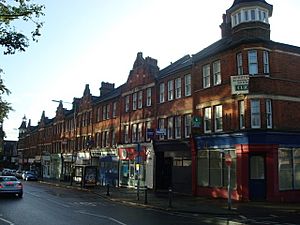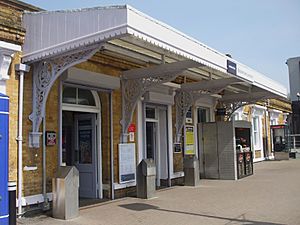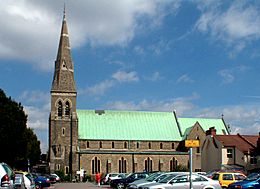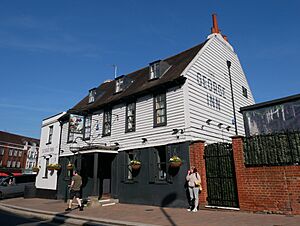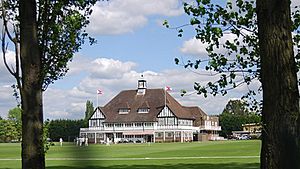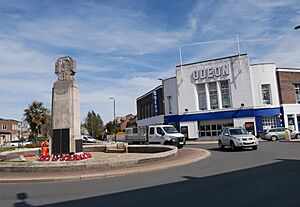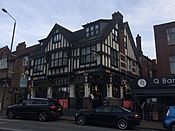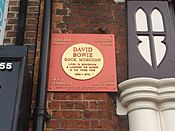Beckenham facts for kids
Quick facts for kids Beckenham |
|
|---|---|
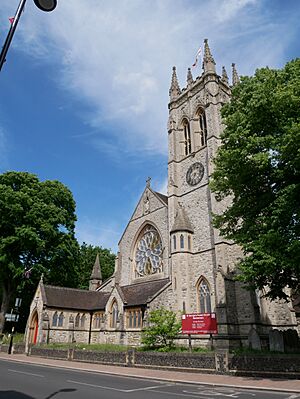 The west face of St George's Church, Beckenham |
|
| Area | 13.22 km2 (5.10 sq mi) |
| Population | 46,844 (2011 Census |
| • Density | 3,543/km2 (9,180/sq mi) |
| OS grid reference | TQ3769 |
| London borough | |
| Ceremonial county | Greater London |
| Region | |
| Country | England |
| Sovereign state | United Kingdom |
| Post town | BECKENHAM |
| Postcode district | BR3 |
| Post town | LONDON |
| Postcode district | SE20 |
| Dialling code | 020 |
| Police | Metropolitan |
| Fire | London |
| Ambulance | London |
| EU Parliament | London |
| UK Parliament |
|
| London Assembly |
|
Beckenham is a town located in Greater London, England. It's part of the London Borough of Bromley. Before 1965, Beckenham was actually part of Kent. It sits about 8.4 miles (13.5 km) south-east of Charing Cross, a famous spot in central London. In 2011, about 46,844 people lived here.
For a long time, Beckenham was just a small village. Most of its land was countryside or private parks. But in 1857, something big happened: the railway arrived! This changed everything. A family named Cator started selling and leasing land for new houses. This caused the population to grow super fast, from 2,000 people in 1850 to 26,000 by 1900. Even after that, more homes were built, and the population kept growing, just a bit slower.
Today, Beckenham has many shops and businesses, especially around its main street. It's easy to get around thanks to its three main railway stations, with nine stations in total within the wider area. There are also two Tramlink stations on the western side. Like other parts of Bromley, Beckenham has lots of green spaces. These include sports fields, fishing ponds, and parks where people can relax and play.
Contents
- What Does Beckenham Mean?
- Beckenham's Past: A Quick Look
- How Beckenham is Governed
- Beckenham's Location and Nature
- Businesses in Beckenham
- Getting Around Beckenham
- Churches and Places of Worship
- Population Details
- Fun Things to Do in Beckenham
- Schools in Beckenham
- Sports in Beckenham
- Beckenham in Books and Shows
- Famous People from Beckenham
- Images for kids
What Does Beckenham Mean?
The name 'Beckenham' is very old. It was first written down in a Saxon document in 862 as Biohhahema mearc. Later, in the Domesday Book of 1086, it was called Bacheham. The name probably comes from Beohha's homestead, which means 'Beohha's home' in Old English. There's also a small stream here called the River Beck. It's likely that the river was named after the village, not the other way around!
Beckenham's Past: A Quick Look
We don't have many early written stories about Beckenham. But we do know about it from the Domesday Book of 1086. Other old documents also mention the area. Historians like Thomas Philipott and Hasted wrote about Beckenham's history. They described the main estates like Beckenham Manor, Foxgrove Manor, Kelsey, and Langley.
Archaeologists have found old tools from the Stone Age and Bronze Age nearby. This shows that people lived here a very long time ago. The Romans even had a camp here, and a Roman road called the London to Lewes Way passed through the area.
When the Normans arrived, much of modern Beckenham was part of the Beckenham manor. Other parts were covered by the Foxgrove, Kelsey, and Langley estates. Over time, these lands changed hands between many different families.
Beckenham stayed a small village until the 1800s. Its big growth started after 1825. This is when the large estates of John Barwell Cator and Lord Gwydir began to be developed. When the railway arrived in 1857, it made things even faster. Big, fancy houses with wide roads and large gardens were built around the new station.
The Kelsey Estate, for example, was named after an old manor called Kelsies. In the 1700s, a large house was built there, overlooking a lake. This house was later rebuilt, but it was pulled down in 1921. The land then became Kelsey Park, which is a beautiful park today. Only two old lodge cottages at the park's entrance are still standing from that time.
In 1876, Beckenham Cemetery opened. It's located south of the town.
Beckenham Today
Today, Beckenham is a busy suburb of London. But it still feels like its own town. The town centre has a curving high street with lots of shops. More shops can be found along Bromley Road, Croydon Road, and Beckenham Road. The town's library is near Clock House station. To the north is New Beckenham, which is mostly a residential area.
How Beckenham is Governed
In 1935, Beckenham became a Municipal Borough. This meant it had its own local government, called the Beckenham Urban District Council, which had been around since 1894. This new status showed how much Beckenham had grown in less than 50 years.
Before 1965, Beckenham was part of Kent. But in 1965, when the Greater London Council was created, Beckenham became part of the new London Borough of Bromley. Local councillors now represent different parts of Beckenham within this borough.
Beckenham's Location and Nature

Beckenham is about 1.7 miles (2.7 km) west of Bromley and 3.8 miles (6.1 km) north-east of Croydon.
The original village was surrounded by large estates like Beckenham, Foxgrove, Kelsey, Langley, and Kent House Farm. These estates had big houses and parks. The town's boundaries have changed over time, but they used to stretch from Crystal Palace Park to Bromley and from Lewisham to West Wickham.
The River Ravensbourne flows north along the eastern side of Beckenham. A smaller stream, the River Beck, also flows through the town before joining the Ravensbourne further north. The area has many small hills and is made of a type of clay called London Clay. This clay was used for brickworks when the town was being built.
Businesses in Beckenham
Beckenham is home to some important businesses. For example, Capita Registrars Limited, a company that helps manage shares for many UK companies, has its headquarters here. Proper Records, one of the UK's biggest independent music distributors, used to be based in Beckenham before moving in 2017.
Getting Around Beckenham
Trains
Beckenham town centre is served by Beckenham Junction station. Other stations like Clock House, New Beckenham, and Kent House serve the areas around the town.
- Trains from Beckenham Junction and Kent House go to central London every 15 minutes. It takes about 13 minutes to get to Brixton and 21 minutes to London Victoria.
- Beckenham Junction also has trains to London Bridge every 30 minutes (about 35 minutes travel time). You can also get to Orpington in about 17 minutes.
- Stations like Ravensbourne and Beckenham Hill offer direct trains to central London and the City every 30 minutes. You can reach London Blackfriars in 27 minutes and London St Pancras in 37 minutes.
- New Beckenham and Clock House stations have services to London Charing Cross, London Bridge, and London Cannon Street.
Trams
Tramlink also serves Beckenham. You can catch trams from Beckenham Junction and Beckenham Road to Wimbledon, passing through East Croydon.
Buses
Many Transport for London buses run through Beckenham. They connect the town to other areas like Bromley, Croydon, Crystal Palace, Lewisham, and Woolwich.
Churches and Places of Worship
Beckenham has many places of worship. St. George's Church is the main parish church in the town centre. It was mostly rebuilt in the late 1800s, but parts of an older building date back to 1100. It has a very old lych gate from the 1200s, which is one of the oldest in England. The almshouses next to the church were built in 1694.
There are also other Anglican churches in Beckenham, such as All Saints Church and Holy Trinity Church. You can also find Methodist and Baptist churches, and a Roman Catholic church dedicated to St Edmund of Canterbury.
Population Details
Beckenham is divided into different areas called wards. In 2011, the population of these wards was:
| Ward | Usual residents | km2 |
|---|---|---|
| Clock House | 15,560 | 2.27 |
| Copers Cope | 15,392 | 3.29 |
| Kelsey and Eden Park | 15,892 | 5.20 |
| Shortlands | 9,824 | 2.46 |
As a whole, the Beckenham area, including its post town, had over 82,000 people in 2011.
Fun Things to Do in Beckenham
Beckenham has many clubs and groups for leisure activities. The local Odeon cinema has six screens and is a historic building. Every November, the Beckenham Festival of Music and Dancing takes place. If you like plays, the Beckenham Theatre puts on amateur shows. The Beckenham Concert Band is a community band that raises money for charity and performs locally.
The South East London Green Chain, a long walking path, goes through Beckenham. Both Cator Park and Beckenham Place Park are part of this path. Other green spaces include Croydon Road Recreation Ground and Kelsey Park. You can even take a walk that starts in Cator Park, goes through the High Street, Kelsey Park, and Croydon Road Recreation Ground, and then back to Cator Park. Beckenham Green, in the town centre, often hosts markets and other events.
Schools in Beckenham
Beckenham has several secondary schools. These include Harris Academy Beckenham, Harris Academy Bromley, and the two Langley Park schools: for boys and for girls. Eden Park High School is also in the area.
There are also many primary schools. Some of these are Bishop Challoner (an independent Roman Catholic school), St Mary's Catholic Primary School, and Balgowan Primary School.
Sports in Beckenham
Beckenham has its own non-League football club, Beckenham Town F.C.. They play at Eden Park Avenue. There's also a Sunday league team called Beckenham Manor Football Club.
Beckenham Cricket Club plays at Foxgrove Road. Famous England cricketers like Derek Underwood and Richard Ellison played here. From 1886 to 1996, the club also hosted the Kent Championships, a big international tennis tournament. Many top players came to play here before Wimbledon. In 1968, it even held the world's first "open" grass-court tournament, where both amateur and professional players could compete.
Beckenham Rugby Football Club is a rugby union club that started in 1894. They have many teams, including a successful women's team and one of the biggest youth sections in the South East of England. Another rugby club, Beccehamians RFC, plays nearby.
Beckenham Cricket Club is also home to the Bromley and Beckenham Hockey Club. Swimmers from Beckenham Swimming Club, which started in 1893, have won medals at national and international competitions. New Beccehamian Hockey Club also plays its home games in Beckenham.
The training ground for the Premier League football club Crystal Palace is located on Copers Cope Road in Beckenham.
Beckenham in Books and Shows
Beckenham has appeared in popular culture. In the BBC Radio 4 comedy No Commitments, one of the characters, Victoria, lives in Beckenham, and the town is often joked about. Beckenham is also a main setting in the novel The Buddha of Suburbia (1990) by Hanif Kureishi.
Famous People from Beckenham
Many famous people were born or have lived in Beckenham.
- Politicians and Leaders: These include George Eden, 1st Earl of Auckland (a colonial administrator) and William Eden, 1st Baron Auckland (a politician). Former British Prime Minister John Major lived in Beckenham from 1974 to 1978.
- Writers: Enid Blyton, who wrote many children's books, lived in Beckenham when she was young. Walter de la Mare and A.L. Barker were also writers from the area.
- Show Business: Famous people from TV and film include comedian Bob Monkhouse, actress Julie Andrews, and children's TV presenter Floella Benjamin.
- Musicians: The legendary music artist David Bowie lived in Beckenham from 1969 to 1973. Other musicians include Rolling Stones bassist Bill Wyman, Peter Frampton, David Sylvian, Andy Bown (from Status Quo), and Anne Dudley (from Art of Noise).
- Sports: Many famous cricketers have come from Beckenham, as well as Tom Pettitt, a world champion in real tennis.
Images for kids



